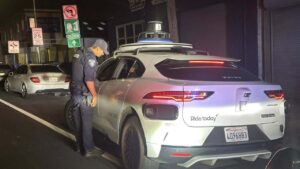
(Image credit: Scrippsnews.com)
Last week in San Bruno, California, local police at a DUI checkpoint executed a flawless stop—only to pull over absolutely nothing. No drunk driver, no intoxicated passenger, and no one in the front seat. Instead, they found a Waymo robo-taxi that had just made an illegal U-turn right in front of them.
When a human driver breaks the law, you pull them over, hand them a ticket, or haul them to court. But when a car does it and there is no person behind the wheel? The traditional legal tools break down- most jurisdictions haven’t yet updated their statutes to enable citing driverless cars even though these are growing significantly. At least in California that will change in 2026 when hashtagAB1777 statute passes, allowing law enforcement to issue “notices of autonomous vehicle noncompliance” for observed violations.
Fact remains though- even as we embrace productivity gains from hashtagAI, examples like this highlight the level of regulatory overhaul that is required to keep up with the blistering pace of AI adoption.